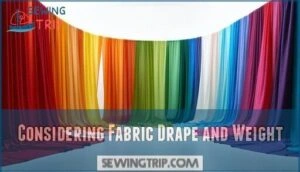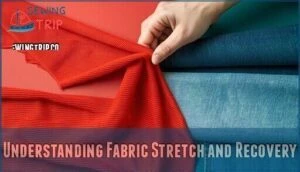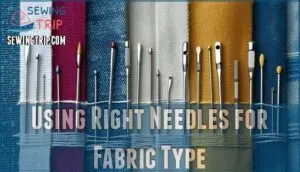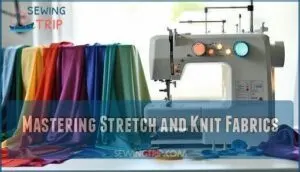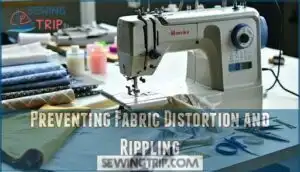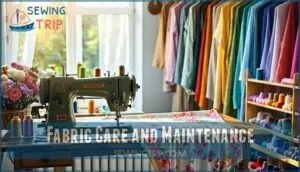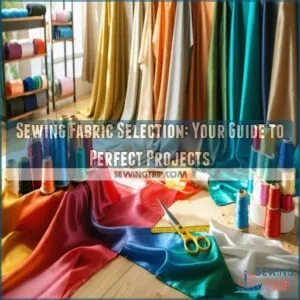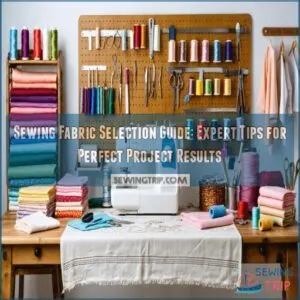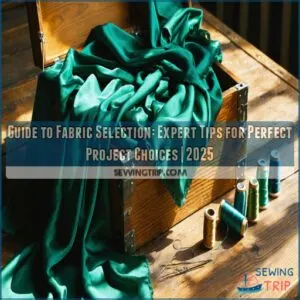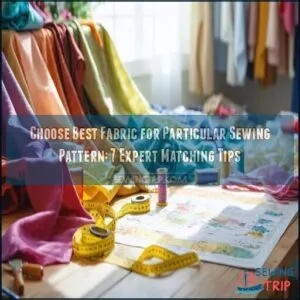This site is supported by our readers. We may earn a commission, at no cost to you, if you purchase through links.
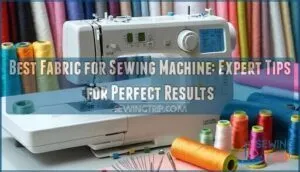
Cotton works brilliantly for beginners – it’s forgiving, stable, and feeds through most machines smoothly.
Polyester blends offer durability with easy care, while lightweight fabrics like chiffon need gentle handling and sharp needles.
Heavy materials like denim require strong machines and appropriate needles.
Consider fabric weight, stretch, and weave pattern when choosing.
Natural fibers breathe well but may shrink, while synthetics resist wrinkles and hold their shape.
Your machine’s capabilities matter too – some handle thick layers better than others.
Match your fabric choice to both your skill level and your machine’s strength for professional-looking results that won’t leave you wrestling with frustrating jams or skipped stitches.
Table Of Contents
Key Takeaways
- Choose cotton for best results – You’ll find that cotton is the most forgiving fabric for beginners, feeding smoothly through machines while hiding mistakes and providing stable, breathable results.
- Match fabric weight to your machine’s capabilities – You need to consider your machine’s strength when selecting materials, using lightweight fabrics (4-7 oz) for basic machines and reserving heavy materials, like denim, for stronger equipment.
- Use proper needles and techniques for each fabric type – You’ll prevent jams and skipped stitches by matching needle size to fabric weight (9/70 for lightweight, 14/90 for heavy) and using ballpoint needles for stretchy materials.
- Pre-wash fabrics before sewing – You can avoid project disasters by washing fabrics first to prevent shrinkage and color bleeding, following care labels for proper temperature and drying methods.
Fabric Types Matter
Your fabric choice can make or break your sewing project, and not every material plays nicely with every machine.
Understanding the characteristics of different fabric types helps you select materials that’ll feed smoothly through your machine and create professional-looking results, as your fabric choice is crucial for a successful project with smooth execution.
Natural Fabrics for Sewing
Natural fabrics offer unmatched versatility for your sewing projects.
Natural fabrics bring timeless beauty and effortless elegance to every sewing project you touch.
Cotton versatility makes it perfect for beginners, while linen breathability keeps you cool in summer garments.
Wool warmth wraps you in cozy comfort, and silk elegance adds luxury to special pieces.
Recycled polyester offers a sustainable alternative.
Here’s why natural fabrics win hearts:
- Cotton forgives mistakes – It’s forgiving when you’re learning new techniques
- Linen gets better with age – Each wash makes it softer and more beautiful
- Wool holds its shape – Your garments maintain their fit wash after wash
- Silk feels like a dream – Nothing compares to that smooth, luxurious touch
Synthetic Fabrics for Durability
When you’re building projects meant to last, synthetic fabrics deliver unmatched durability.
Polyester resists wrinkles, dries quickly, and maintains its shape through countless washes.
Rayon offers silk-like drape at budget-friendly prices, while nylon provides exceptional strength for activewear.
These synthetic blends handle frequent use without breaking down, making them perfect for children’s clothing, work uniforms, and outdoor gear where longevity matters most.
Blends and Specialties for Versatility
While synthetic fabrics offer durability, fabric blends and specialty fabrics bring versatility to your projects.
Denim durability meets jersey comfort when you choose cotton-spandex blends.
Velvet texture adds luxury, while brocade effects create dramatic statements.
Lace aesthetics elevate simple designs into stunning pieces.
These fabric types combine different fiber properties, giving you the best of both worlds for creative sewing success, and bringing luxury to your projects through the combination of different materials.
Choosing Fabric Wisely
Smart fabric selection transforms your sewing from frustrating to fabulous, starting with understanding how different materials behave under your machine’s needle.
The right fabric choice is the difference between sewing success and endless frustration.
You’ll save time, thread, and sanity by matching fabric properties to your project’s needs before you even cut your first piece, which is a key step in making your sewing fabulous.
Considering Fabric Drape and Weight
Everyone knows the secret to professional-looking garments lies in understanding fabric drape and weight.
Fabric stiffness determines how your creation hangs—crisp cotton poplin creates structured shapes while fluid rayon flows beautifully for flowy garments.
Weight categories guide project matching: lightweight fabrics (4-7 oz) suit summer tops, medium-weight (7-11 oz) works for everyday wear, and heavyweight (11-14 oz) handles jackets.
Test drape types by holding fabric up—gravity reveals the best sewing fabric for your vision.
Understanding Fabric Stretch and Recovery
After weighing drape and weight, focus on fabric stretch and recovery.
Stretch Percentage shows how far a fabric—like spandex or knit fabrics—can extend, while Recovery Importance measures its bounce-back.
Knit vs Woven matters: knits stretch, wovens rarely do.
Stretch Types—2-way or 4-way—impact comfort and fit.
Always match fabric properties to your project considerations for best results, considering the fabric stretch for optimal outcomes.
Selecting Fabric for Specific Projects
Match your fabric selection to your project’s garment type and skill level for best results.
Consider fabric weight against pattern complexity, ensuring your chosen material supports the design’s requirements. Pattern matching becomes easier when you understand fabric characteristics and their intended uses.
Fabric properties affect the drape and texture of the final piece.
- Cotton quilting fabric transforms beginner projects into confidence-building victories
- Stretch jersey creates comfortable garments that move with your body perfectly
- Linen offers forgiving texture that hides small mistakes while looking professional
Sewing Techniques for Fabrics
You’ll master fabric handling once you understand how different materials behave with your sewing machine.
The right needle, proper tension, and specific techniques for each fabric type transform challenging projects into smooth, professional results.
Using Right Needles for Fabric Type
Success in sewing depends on matching your needle to your fabric—it’s the foundation of flawless stitching.
Universal needles work for most woven fabrics and synthetics, while ballpoint needles prevent runs in knits.
Choose needle sizes based on fabric weight: 9/70 for lightweight materials, 11/80 for medium fabrics like cotton, and 14/90 for heavier materials to prevent skipped stitches and guarantee proper thread tension.
Using the correct needle selection improves sewing skill and enjoyment.
Mastering Stretch and Knit Fabrics
Once you’ve selected the right needle, stretch and knit fabrics demand specific techniques for professional results. These stretchy materials behave differently than woven fabrics, requiring adjustments to your sewing approach.
Use ballpoint or stretch needles to prevent fabric damage and skipped stitches. Choose zigzag stitches for seams that stretch without breaking. Lower your presser foot pressure to avoid stretching seams during sewing. Understanding stretch percentages is essential for selecting the right fabric for your project.
- Double needles create gorgeous hems that stretch with jersey knit movements
- Walking foot attachments feed knit fabrics evenly through your machine
- Testing stitches on scraps saves you from heartbreak on finished projects
- Polyester thread flexibility prevents seam breakage under tension
- Natural fabric feeding eliminates unwanted rippling and distortion
Preventing Fabric Distortion and Rippling
Stay-stitching curved edges prevents stretching while pinning fabric ends first stops shifting during sewing.
Adjust your sewing machine tension and presser foot pressure for different fabric types sewing projects.
Use stabilizers on lightweight materials and support heavy fabrics to avoid rippling.
For best results, consider sewing with stabilizers on delicate fabrics.
Test feed dogs settings with fabric scraps before final construction, ensuring proper seam finishes without distortion, and always use proper seam techniques.
Fabric Care and Maintenance
You’ll get the best results from your sewing machine when you properly care for your fabrics before and after each project.
Learning correct washing, drying, and pressing techniques guarantees your finished garments maintain their shape, color, and professional appearance for years to come.
Washing and Drying Fabrics Correctly
Pre-wash importance can’t be overstated when working with fabrics.
This vital step prevents nasty surprises like fabric shrinkage and color bleeding that’ll ruin your finished project.
Follow these essential fabric preparation guidelines:
- Cotton and linen: Machine wash in warm water, tumble dry on warm heat
- Delicate fabrics: Hand wash silk and wool in cold water, air dry flat
- Synthetics: Use cool water cycles, low heat drying to maintain elasticity
Always check care labels before prewashing—they’re your roadmap to proper fabric care and longevity.
To prevent damage, consider gentle cycle settings for delicate items.
Ironing and Pressing Fabrics for Finish
The right ironing temperatures and pressing techniques transform your finished garments from homemade to professional-looking.
Cotton handles high heat with steam settings, while delicate fabrics like silk need low temperatures without steam.
Use pressing cloths and proper ironing tools to protect fabric finishes. Explore options for specialized pressing materials to further protect your fabrics.
Master these ironing techniques for crisp, polished results that showcase your fabric preparation skills.
Selecting Best Fabric for Machine
Your sewing machine’s capabilities determine which fabrics you can handle successfully, and choosing the right match prevents frustration and costly mistakes.
Understanding fabric thickness, seasonal needs, and your machine’s limitations guarantees smooth sewing and professional results every time.
Considering Fabric Thickness and GSM
Understanding fabric weight and GSM becomes your secret weapon for sewing success.
GSM (grams per square meter) measures fabric thickness, directly impacting your project’s outcome and your sewing machine’s performance.
Here’s your GSM breakdown for smarter fabric selection:
- Lightweight fabrics (60-150 GSM): Perfect for blouses, linings, and delicate garments but may require stabilizing
- Medium-weight fabrics (150-250 GSM): Ideal beginner choice offering stability and versatility for most projects
- Heavy-weight fabrics (250-400 GSM): Great for coats, bags, and structured garments but test your machine’s limits first
- Ultra-heavy fabrics (400+ GSM): Requires industrial machines, avoid with standard home equipment
- Drape impact varies by weight: Lighter fabrics flow gracefully while heavier ones create structured silhouettes
Choosing Fabric for Seasonal and Occasional Use
Your fabric choices directly impact your sewing machine’s performance across different seasons and occasions.
Summer calls for lightweight cottons and linens that provide seasonal fabric breathability, while winter projects benefit from wool and fleece for warmth.
Special occasions demand fabrics with appropriate formality and durability.
| Season/Occasion | Recommended Fabrics |
|---|---|
| Summer/Spring | Cotton, linen, rayon challis |
| Fall/Winter | Wool, fleece, corduroy |
| Formal Events | Silk, brocade, velvet |
| Casual Wear | Cotton blends, jersey knits |
Holiday fabric themes and weather-appropriate textiles guarantee your projects match their intended use perfectly, considering the seasonal and durability aspects.
Matching Fabric to Sewing Machine Capability
Your sewing machine has specific limits that determine which fabrics work best. Machine limitations affect everything from needle compatibility to feed dog performance, so matching fabric thickness to your equipment prevents frustration and broken needles.
Consider these key factors when selecting sewing machine material:
- Fabric weight sewing: Test medium-weight fabrics (160-200gsm) first – they’re easiest for most machines to handle
- Needle compatibility: Match needle size to fabric thickness – universal needles work for cotton, ballpoint for knits
- Stitch settings: Adjust tension and length based on fabric type to prevent skipped stitches or jamming
The best fabric for sewing machine success balances your project needs with your equipment’s capabilities.
When sewing knits, remember to use ballpoint needles to avoid damaging the fabric.
Frequently Asked Questions (FAQs)
What’s the best fabric to sew with?
Cotton is your best starting point. It’s forgiving, breathable, and easy to handle on any sewing machine. Cotton doesn’t fight back like slippery synthetics or stretch unexpectedly like knits do.
What is the easiest material to sew with?
Cotton is your best bet for beginners.
It’s forgiving, doesn’t fray much, and handles mistakes well.
Quilting cotton offers structure while jersey knit provides stretch.
Both are affordable and easy to handle through your machine.
Is cotton or polyester thread better for a sewing machine?
Like choosing the right thread for your sewing machine’s dance, polyester thread outperforms cotton for most projects.
It’s stronger, more durable, and won’t break under tension, making your stitches last longer.
What is the highest quality fabric for clothes?
You’ll find silk stands as the pinnacle of clothing fabrics, offering unmatched luxury, breathability, and drape.
Its natural protein fibers create garments that feel incredible against skin while regulating temperature beautifully throughout seasons, providing luxury.
How do I prevent fabric jamming in my machine?
Over 70% of sewing machine jams occur due to improper threading or tension issues.
Use quality thread, clean your machine regularly, check needle sharpness, and make certain proper fabric-to-needle matching to prevent frustrating jams.
This will help to prevent frustrating jams and ensure smooth operation of your sewing machine.
Which fabrics cause the most thread breakage issues?
Delicate fabrics like silk, chiffon, and organza frequently cause thread breakage due to their fine weave and slippery texture.
You’ll also struggle with thick materials like denim and canvas when using inappropriate needles or incorrect tension settings, which can be considered a critical issue.
Whats the minimum fabric thickness for zigzag stitches?
Think of zigzag stitches as tiny waves dancing across fabric – they need substance to grip.
You’ll want fabric at least medium-weight, around 7-11 oz GSM, for zigzag stitches to work properly without puckering or skipping.
Conclusion
Success in sewing, much like a skilled captain traversing diverse waters, depends on choosing the right vessel for your journey.
The best fabric for sewing machine work transforms your creative vision into reality when you match material properties to your machine’s capabilities. Whether you’re working with forgiving cotton or challenging stretch fabrics, understanding fabric weight, drape, and fiber content guarantees smooth sailing.
Remember that your machine’s strength and your skill level must align with fabric demands. By following these guidelines, you’ll avoid common pitfalls and achieve professional results every time, ensuring that your projects turn out as envisioned, with the right balance of fabric weight and drape.
- https://www.blackbirdfabrics.com/en-us/blogs/resources/the-five-best-fabrics-for-beginners-start-learning-with-these-easy-to-sew-fabrics
- https://www.cre8iveskill.com/blog/top-ten-fabrics-for-machine-embroidery-designs
- https://organiccottonplus.com/
- https://www.google.com/search?q=weaving+fabric&sca_esv=3a3d99a76b27b006&sca_upv=1&udm=2&sxsrf=ACQVn0-fDXK-Ydwq4N8rgF2w9bmc7JrH4w%3A1713408248893&ei=-IggZsCQNqeJ4-EP3oeNuAI&oq=weaving+fabric&gs_lp=EhNtb2JpbGUtZ3dzLXdpei1zZXJwIg53ZWF2aW5nIGZhYnJpYzIKEAAYgAQYQxiKBTIFEAAYgAQyBRAAGIAEMgUQABiABDIFEAAYgARImB9QAFgAcAB4AJABAJgBqwGgAasBqgEDMC4xuAEDyAEAmAIBoAKyAZgDAIgGAZIHAzAuMaAH2AI&sclient=mobile-gws-wiz-serp
- https://www.moodfabrics.com/ramillies-cosmic-sky-calendered-organic-cotton-chambray-323193

